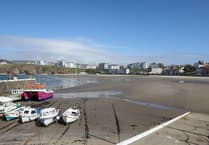The government has said that the 'beads' which have appeared in the sea and on the beach at Port Erin have come from the former Marine Biological Station.
It was speculated this morning that the 'small polystyrene balls' had come from there and were harming the environment.
The Department of Environment, Food and Agriculture says this is correct and it is 'a legacy issue'. An officer from the department visited the site today.
It said: 'DEFA has been monitoring the site for a couple of months and been in discussion with the developer. The beads appear to be from the demolition in March, when the vast majority were safely removed from the site and surrounding area.
'However, due to their size it is extremely difficult to ensure they were all gathered up and disposed of properly. DEFA has reminded the developer of their responsibility to ensure the site does not pollute the environment and also continues to liaise with the ecological advisors (MWT) for the site.'
Beach Buddies said the beads had been described by observers as being in their 'millions' and had appeared to have been released from the 'cavity walls of the building which had been filled with the polystyrene for insulation purposes'.
Susan Rossouw, a supporter of Beach Buddies, said she was 'dismayed' by the incident.
She said: '[The beach] is full of these little polystyrene balls. They are clustered in hollows where there is seaweed and on the tideline . . . millions and millions of virtually indestructible little balls. It is very sad indeed, and for me quite depressing.
'My husband worked in building and he suggests that this material was used in cavity insulation, and when the building [Marine Biological Station] was demolished it has all been released.'
A spokesperson for Beach Buddies added: 'If this really is proved to be a case of the polystyrene coming from cavity insulation at the Marine Biological Station then someone needs to explain how this has been allowed to happen. Polystyrene causes massive damage to wildlife, because animals can’t distinguish the difference between materials like this and items such as fish eggs.
'The Isle of Man has a worldwide reputation for its care for the environment as a UNESCO Biosphere Reserve. We need everyone across the community to be involved, and in this case it appears we have not been thinking through the results of our actions.'





Comments
This article has no comments yet. Be the first to leave a comment.